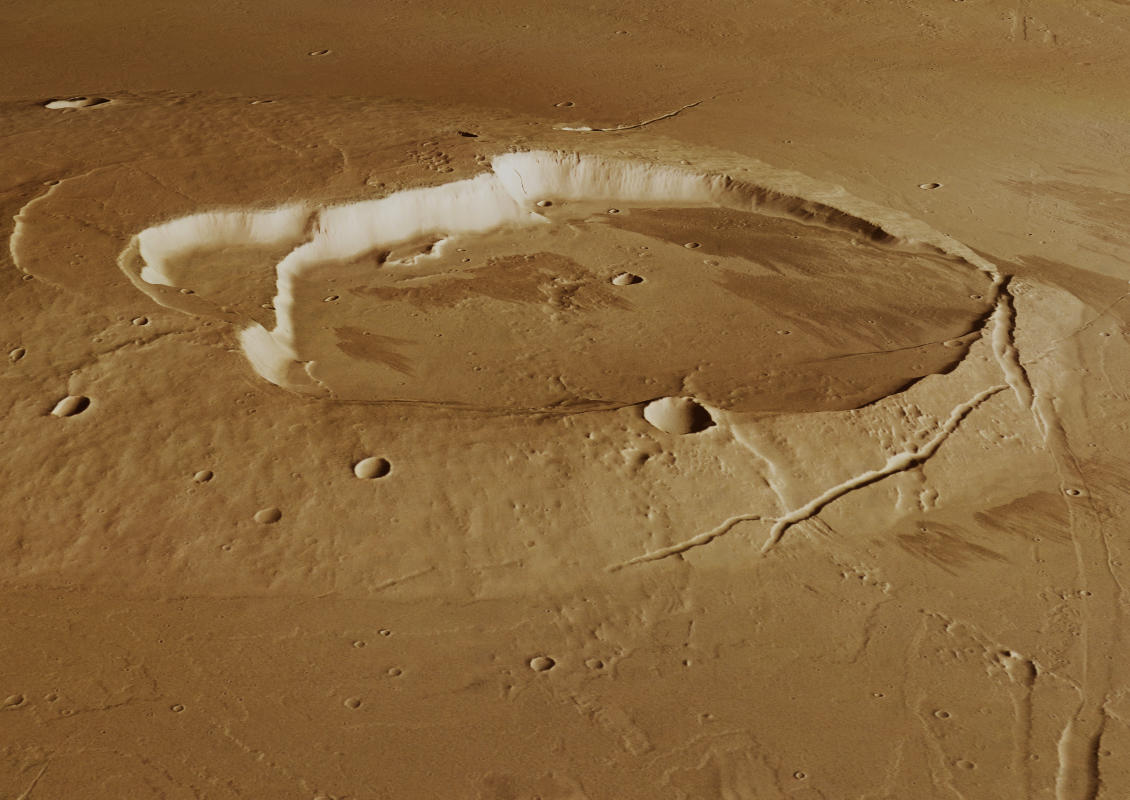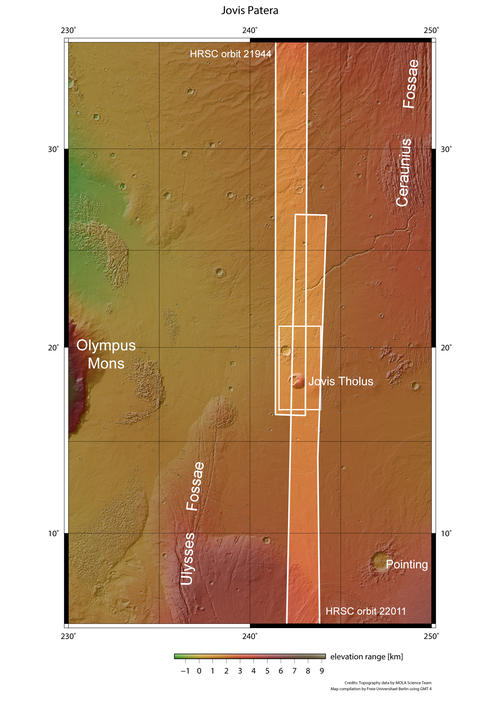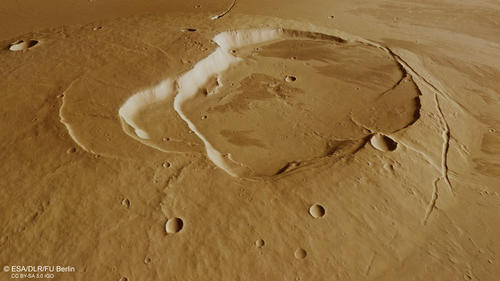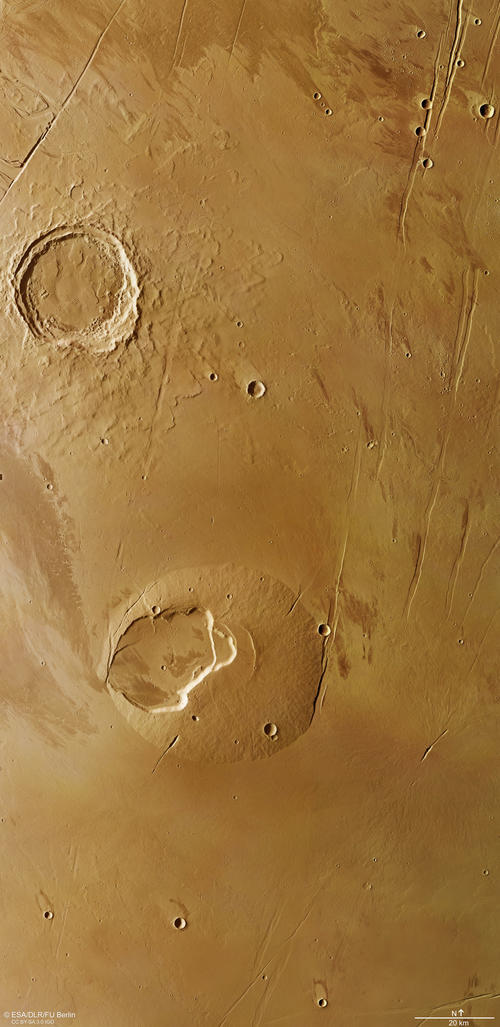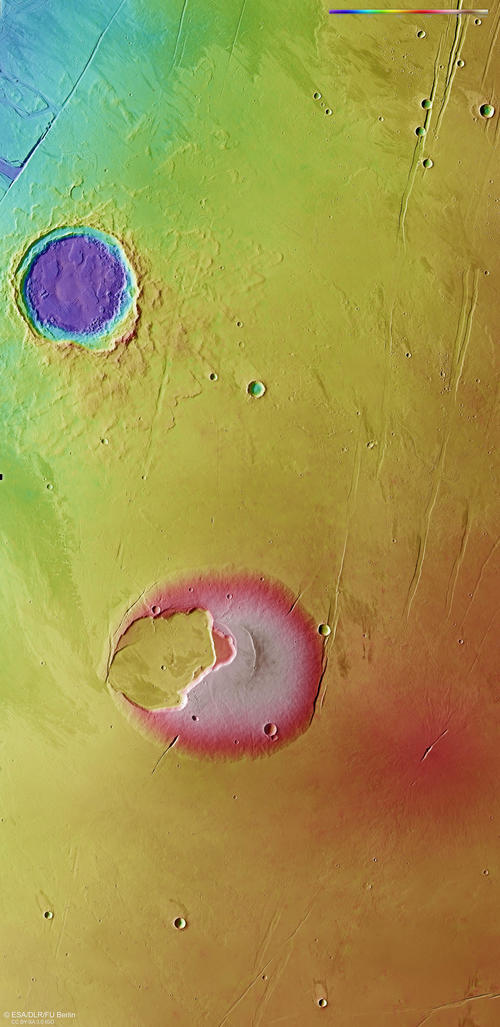Department of Earth Sciences
Service Navigation
Jovis Tholus Volcano - sunken in a lava sea
Image data by the High Resolution Stereo Camera (HRSC) on board ESA’s Mars Express mission show the Jovis Tholus volcano and multiple other landforms in the Tharsis region of Mars. The High Resolution Stereo Camera (HRSC) is a camera experiment that was developed and is operated by the German Aerospace Center (Deutsches Zentrum für Luft- und Raumfahrt; DLR).
» read more in the main article and below the gallery about the Jovis Tholus volcano ...
Jovis Tholus • Position & 3D view
Jovis Tholus context map
Image Credit: MOLA Science Team/FU-Berlin
Jovis Tholus perspective view
Image Credit: ESA/DLR/FU-Berlin
Jovis Tholus HRSC images
Jovis Tholus HRSC color mosaic
Image Credit: ESA/DLR/FU-Berlin
Jovis Tholus HRSC color-coded terrain model
Image Credit: ESA/DLR/FU-Berlin
Jovis Tholus volcano on Mars
» read more about the Jovis Tholus volcano
The Jovis Tholus shield volcano is located roughly in the middle between Olympus Mons and Ascreus Mons. It lies on the very northern edge of the lava plains surrounding the Tharsis Montes and is also bordered by the the Ceraunius Fossae fault system to the northeast and the Ulysses Fossae faults to the southwest. The about 1 km high volcano has a diameter of 58 km and shows a large off-center caldera complex some 28 km in diameter. It shows signs of a long eruptive history, because the caldera contains no less than 5 craters. These calderas align interconnected southwest from the first, the central caldera. Each younger caldera has a slightly lower floor. Like most tholi, Jovis Tholus is surrounded by younger lava flows, obscuring the original relief. These lavas also cover a set of buried graben which can be spotted all around the volcano. The eastern flank of Jovis Tholus is formed by a steep scarp of a north-trending graben. Some portions of this graben are exposed for several kilometers further north into the plains, however often buried by volcanic plains material. At closer look, individual lava flows can be found all over the plains.
A very interesting feature lies just about 30 km east of the volcano flank. Here a second, less developed volcano rises (well visible in the color-coded image). Presumably less viscous flows erupted here from a so-called fissure vent, a structure also known from Iceland or Hawaii on Earth.
But not only volcanic features are present within this image mosaic. The large 30 km wide impact crater 60 km north of Jovis shows a so-called fluidized ejecta layer and a fractured crater floor. This means, that the impactor must have hit a water- or ice saturated ground to form this distinctive ejecta layer.
In addition to this, an outflow-channel system with individual beds measuring from 0.5 to 3.4 km in width emanates directly at the northwestern edge of the sharp graben fault bordering the impact crater (top left edge of the image). The waters were apparently released with bursts forming streamlined islands and terraced channel walls. Some much smaller channels can be found crosscutting the northern ejecta blanket of the large impact crater. Scientists suggest that these massive water amounts were released by perching of a groundwater aquifer while the buildup of the faults took place, or that volcanic warming led to melting of ground ice and the waters then took the easiest way to the surface through the graben system.
Taken all this together, this single HRSC image mosaic paints the picture of a fascinating active planetary history with impacts, volcanos, tectonic graben systems and also river channels.
Fun fact: Jovis Tholus would fit entirely into the caldera of Olympus Mons, the largest volcano in the solar system.
High Resolution Stereo Camera (HRSC)
» information to image origin and processing
The images were acquired by the HRSC (High Resolution Stereo Camera) on 13 May 2021 and 2 June 2021 during Mars Express Orbit 21944 and 22011. The ground resolution is approximately 17 meters per pixel and the images are centered at about 242° East and 19° North. The color image was created using data from the nadir channel, the field of view which is aligned perpendicular to the surface of Mars, and the color channels of the HRSC. The oblique perspective view was generated from the digital terrain model, the nadir and color channels of HRSC. The color-coded topographic view is based on a digital terrain model (DTM) of the region, from which the topography of the landscape can be derived. The reference body for the HRSC-DTM is a Mars equipotential surface (Areoid).
HRSC is a camera experiment that was developed and is operated by the German Aerospace Center (Deutsches Zentrum für Luft- und Raumfahrt; DLR).The systematic processing of the camera data took place at the DLR Institute for Planetary Research in Berlin-Adlershof. The working group of Planetary Science and Remote Sensing at Freie Universität Berlin used the data to create the image products shown here.
To download released raw images and DTMs of the region in GIS-ready formats, follow this link to the mapserver.
Images: ESA/DLR/FU Berlin, CC BY-SA 3.0 IGO
Copyright Notice:
Where expressly stated, images are licenced under the Creative Commons Attribution-ShareAlike 3.0 IGO (CC BY-SA 3.0 IGO) licence. The user is allowed to reproduce, distribute, adapt, translate and publicly perform it, without explicit permission, provided that the content is accompanied by an acknowledgement that the source is credited as 'ESA/DLR/FU Berlin', a direct link to the licence text is provided and that it is clearly indicated if changes were made to the original content. Adaptation / translation / derivatives must be distributed under the same licence terms as this publication.
The High Resolution Stereo Camera was developed at the German Aerospace Center (DLR) and built in collaboration with partners in industry (EADS Astrium, Lewicki Microelectronic GmbH and Jena-Optronik GmbH). The science team, which is headed by Principal Investigator (PI) Dr. Thomas Roatsch, consists of 52 co-investigators from 34 institutions and 11 countries. The camera is operated by the DLR Institute of Planetary Research in Berlin-Adlershof.
